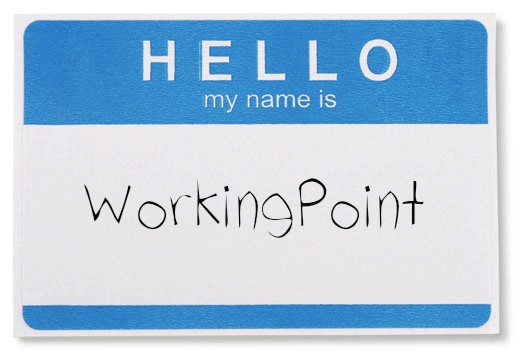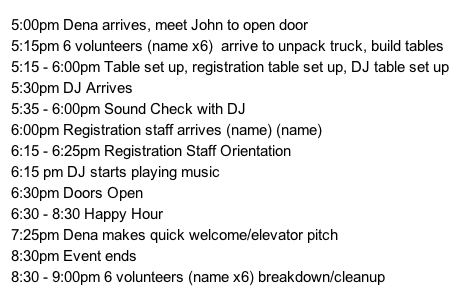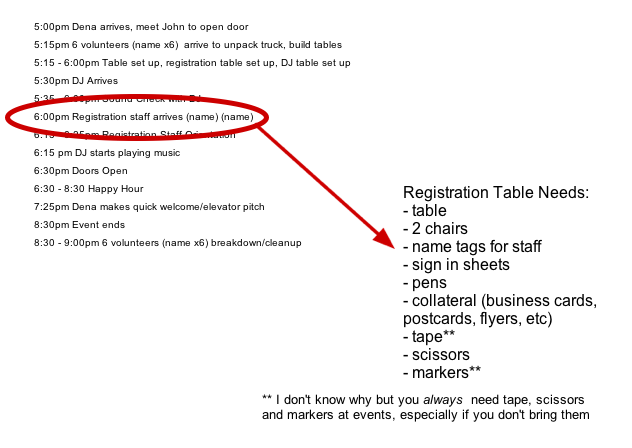Event Planning Checklist: What an Accounting Software can teach you about pulling off a seamless event
Topic: WorkingPoint News | Comments (2)
WorkingPoint has always believed that accounting should be easy, even if you are not an accountant. The intricacies of accounting, revenue, equity, interest, inventory and profit (without the help of some knowledge of accountancy) can be daunting and inaccessible.
The same can be said of pulling off a seamless event. I have seen some of the smartest, most efficient and calm people I have ever known literally fall apart in the process of producing an event. There is something disarming about manipulating lots of dynamic moving parts, not to mention the complete lack of control you have about whether people will show up and of course the inevitable and usually unpredictable monkey wrenches that seem to fall from the sky. Fortunately, much like accounting there are certain steps you can take while planning an event of any size (dinner party for 4, happy hour for 40) that will help you face an event calm, collected, and ready to tackle any challenges that come your way.
These nuggets of advice are hard earned from the hundreds of successful events and programs I have run in the last 5 years and I hope they will help you to produce successful, fun events that benefit your business.
Develop a Goal for the event.
How will you know if the event is successful if you don’t have a goal? Having a clear goal is essential for planning a successful event because it allows you to plan around achieving that goal. Countless times when I’ve hit a price/time/availability road block I’ve stopped and asked “How does this help us to achieve our goal?” or even “Does this help us to achieve our goal ?”. The answer provides clear guidance for whether to move forward or abandon the idea.
Visualize the Outcome You Want
The very first thing I make is a time line for the event. This includes when everyone will be arriving (starting with me as the first one and building up from there), what they will need to do to be ready for the event to start and anything that needs to happen during the event. Having a big picture view of the event will help you to do everything from figure out what you need to bring/buy to how many people you will need to help (only an hour to set up 25 tables? you may want to recruit 10 people for setup).
This usually looks something like this:
Typically I start with the “skeleton”, the essential details that are already finalized like what time I will get the space, how long the event is supposed to last, and how long I will have after the event ends to clean up and get out.
I then fill in details about when I need people to arrive. I believe in giving your people as much notice as possible for when you expect them to be there (and then remind them over and over again, especially one email the day before the event).
Lastly, whenever I plan to say something or make a speech, I always apply the “fashionably late” rule, assuming that people are always going to show up at least 30 minutes after the start of a two hour event. Nobody wants to be the first one there! Plan for up to an hour if the event is going to be 4+ hours long.
Make sure when you are building the time line that each step helps you achieve the goal for the event. Beware of overprogramming (unless this is an event for young children who need to be constantly entertained). Adults like to be masters of their own time, and they really like to mingle/network. If you don’t plan for this time for them, they will find a way to make it and ruin your time line!
Plan for everything & Pack Accordingly
Seriously, the most common things people forget to bring to events are things like pens and sign in sheets, cups, serving utensils and their own business cards. Events are exciting and dynamic, which means it’s easy to get lost in the food/music/fun parts and forget about less exciting details like sign in sheets to capture contact information for event attendants. Visualizing how you imagine the event going and building the time line is very helpful for then creating a packing list that closely mirrors the events realistic supply needs. Like with accounting, it pays to be really detail oriented, to have everything you might possibly need at hand, and to be patient and organized!
I look at each step in the list and determine what to pack for the event (or put out if the event is at your business) like the image below.
Collect Contact Information Before the Event
And make sure everyone has yours. I usually create a single page document that has the time line, the packing list, and the cellphone number of every person who is anyway involved with the event. Then I distribute this list before the event. This should include the name and contact of at least two people if you’re using an outside venue, ditto for food delivery or catering, also the contact info for the DJ, the contact info for any staff and volunteers and include at least 2 ways people can reach you (cellphone, email, landline, carrier pigeon). I also like to let people know where I will be and the best way to reach me at each location. One of the monkey wrenches that always comes up involves people who for whatever reason say they will come and then don’t. It’s better to know that they can reach you and tell you so you can adjust your plan, then spend valuable event time trying to track people down.
In this one sheet, don’t forget to include the Address for the event and information about where to park, how hard parking is, bus routes nearby, cost of parking, cost of cabs. The more details you give your staff the better chance they’ll be on time (and not lost, looking for parking or other common reasons for tardiness). Also let them know if you want them to contact you when they’re running late. Sometimes you need to know, other times the 15 phone calls will keep you from accomplishing important tasks so let them know in advance. My personal preference is to say “Send me a text message if you are going to be more than 15 minutes late”.
Also, I learned the hard way to put all this info on a piece of paper. This prevents some of the catastrophic but scarily common event challenges such as “my cellphone battery died” (you tend to be on the run and using your mobile a lot on the day of the event). I also try to remember to pack my charger on event days.
Sit down and think about everything that could possibly go wrong
And then imagine how you would solve it. This is a terrifying exercise but knowing the potential pitfalls, and then figuring out ways to fix/avoid them, will let you go into that crazy window of event setup/execution knowing that you’ve prepared for every possible situation. There will always be things you don’t think of, but this kind of creative problem solving is habit forming and I believe the pre event exercise in “disaster planning” keeps your mind sharp and ready to respond when those monkey wrenches come flying at your carefully laid plans.
Don’t forget to have fun…
Events are supposed to be fun. For the attendants and for you. In fact, I strongly believe that event attendants can tell when you’re not having fun and it ruins the event for them. A tired/stressed out/anxious host will ruin an event. Make sure that you breathe and relax and have fun and your guests will too. Put it on your time line if you need to.



Pingback: Tweets that mention Event Planning Checklist: What an Accounting Software can teach you about pulling off a seamless event | WorkingPoint -- Topsy.com()